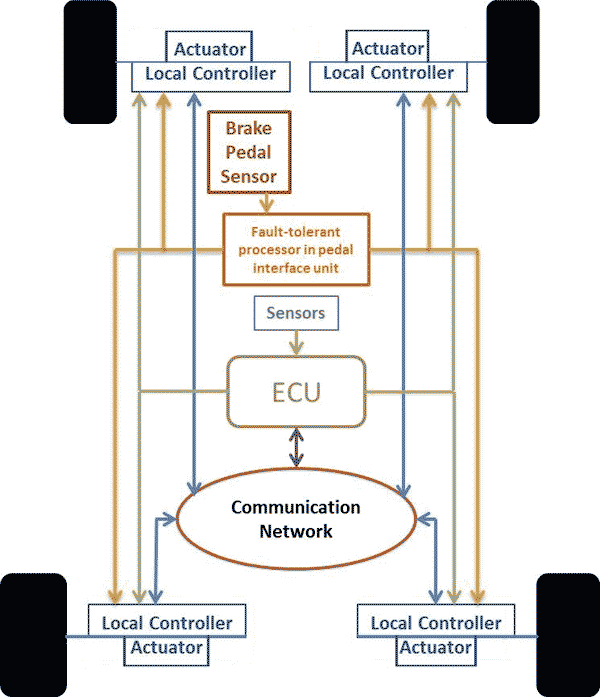Brake-by-Wire
by Abhishek Ramesh, Clemson Automotive Engineering Graduate Student
- Basic Description
-
Brake-by-wire refers to the technology in which mechanical and hydraulic components of traditional braking systems are replaced by electronic sensors and actuators to carry out the function of braking in a vehicle. Brake-by-wire is a combination of electronic control systems coupled with a set of electromechanical actuators and a human-machine interface, which is in this case, the brake pedal. The use of brake-by-wire systems enumerate many benefits such as weight reduction and space saving, lower operating noises and vibrations, and quicker reaction time due to the absence of mechanical linkages, which would result in shorter stopping distances. However for successful application on an extensive basis, the wrinkles in the system's working need to be ironed out to devise a fail-safe version with a clear indication of its distinctive advantages over conventional braking systems, to warm vehicle manufacturers and consumers alike to the idea of its ubiquitous implementation in vehicles.
Due to the safety critical nature of brake-by-wire systems, incorporating a degree of fault tolerance is vital. The most commonly suggested solution is a redundant or back-up brake system, such as a conventional hydraulic system, that would be brought into activation in the event that the primary system suffers a failure.

The schematic representation of a typical brake-by-wire system is depicted in the figure above. A vehicle with brake-by-wire technology employs a set of actuators, most commonly powered by permanent magnet DC electric motors, near each wheel to produce the braking pressures. Each of the actuators is governed by electronic control units that are connected to the brake pedal. The driver's interaction with the brake pedal is converted to a set of electronic instructions, which are communicated throughout the braking system via a communication network, such as CAN (Controller Area Network) or FlexRay. A series of sensors such as brake pedal position sensor, wheel speed sensors, steering angle sensor, yaw rate sensor and lateral acceleration sensors help in appropriate assessment of the situation and accordingly adjusts the braking pressure required. Based on how hard or how far the driver pushes the brake pedal under different circumstances, the sensors transmits information to the ECU, which forms a picture of the mildness or urgency of the braking situation and proportionally decides the required braking pressure to be applied at each wheel. The system is also capable of increasing braking pressure on one side of the vehicle to amend under-steer or over-steer, or adjusting braking pressures on each wheel based on individual grip conditions. In addition, auxiliary systems like ABS, ESC and collision avoidance would work in cohesion with the brake-by-wire system to enhance overall safety and efficiency. With all these systems working in unison, the vehicle's safety is taken to the next level, compensating for driver error or delayed reaction times.
This technology is still in its incipient stages, with its commercial use fairly restricted. As of now, almost fully brake-by-wire systems are used only in the Mercedes-Benz E-Class and SL models and Toyota's Estima, which employ their Sensotronic and Electronically Controlled Brake (ECB) technology respectively. Nissan and BMW are not far away from introducing models with brake-by-wire systems in the near future, while Fiat and Volkswagen follow closely behind.
- Sensors
- Brake-pedal position sensor, lateral acceleration sensor, steering angle sensor, wheel speed sensor, yaw rate sensor.
- Actuators
- Electric motor
- Data Communications
- Controller Area Network (CAN), FlexRay
- For More Information
- [1] Applications Enabled by High-Performance Hybrid Controllers, pages 17 & 18, Bill Hutchings, Freescale.com. (pdf)
- [2] Mercedes-Benz Sensotronic Brake Control (SBC), scribd.com.
- [3] Electronically Controlled Brake, Wikipedia.
- [4] Brakebywire.com
- [5] EWB Braking Technology, YouTube, Nov. 12, 2006.
- [6] Brake-by-wire, aa1car.com.
- [7] Brake-by-Wire Comes To Freight Trains, Robb Mandelbaum, IEEE Spectrum, Feb. 2008.
|

